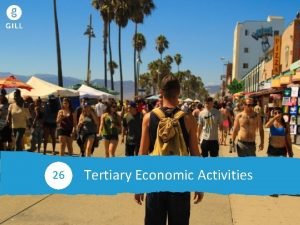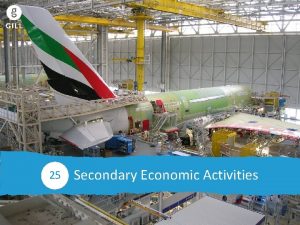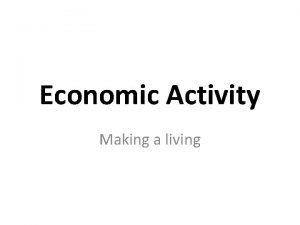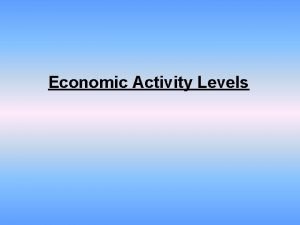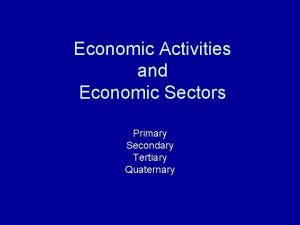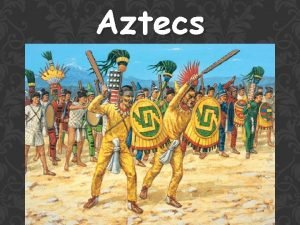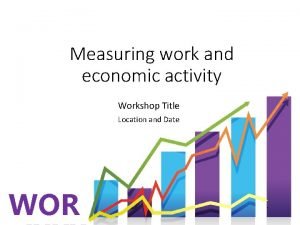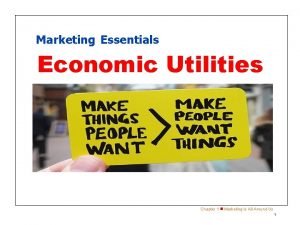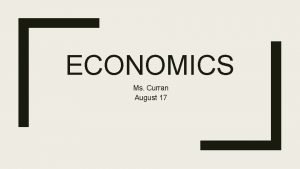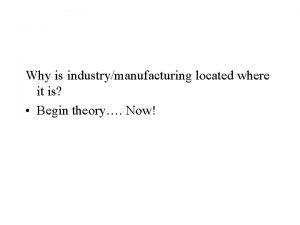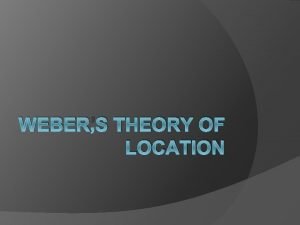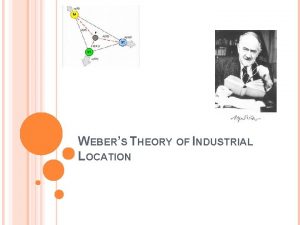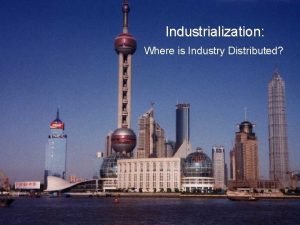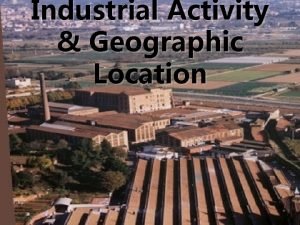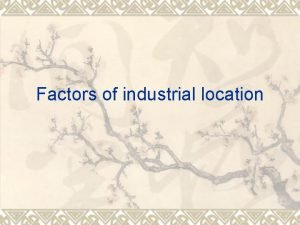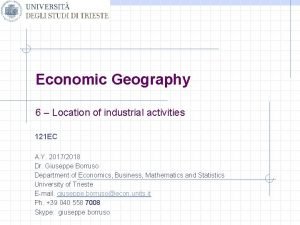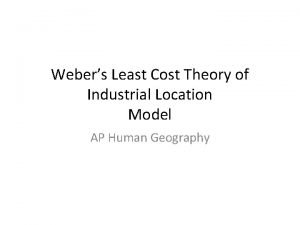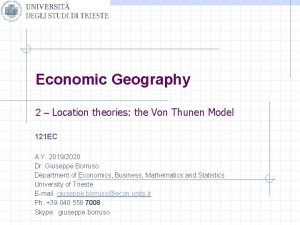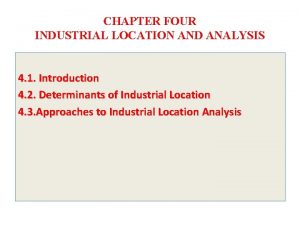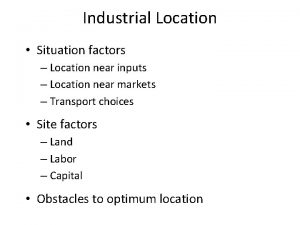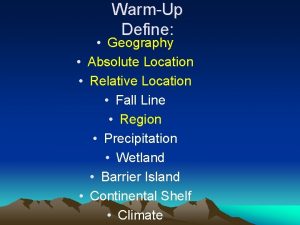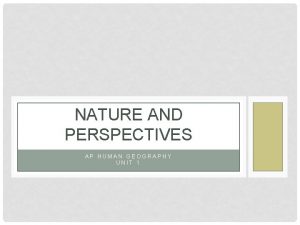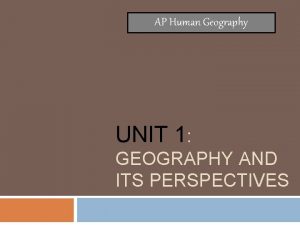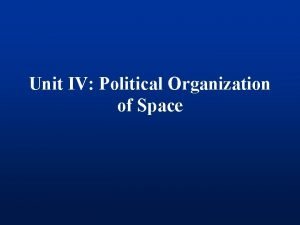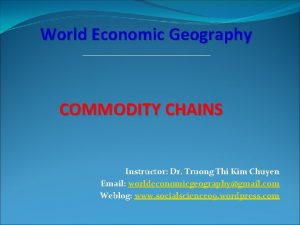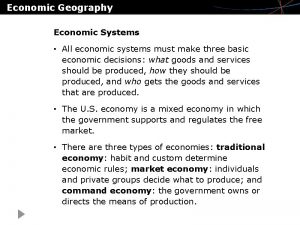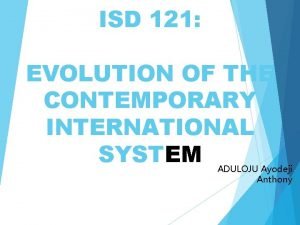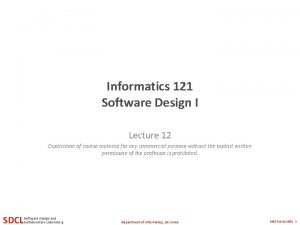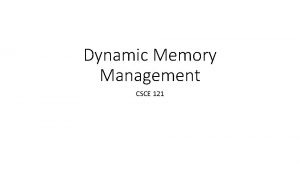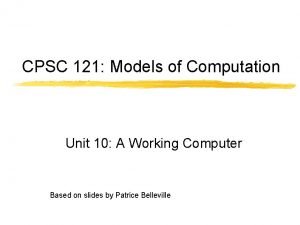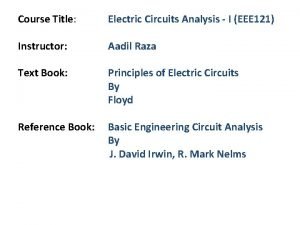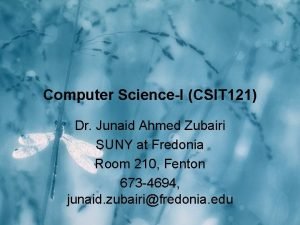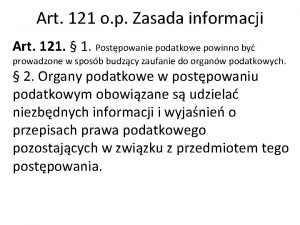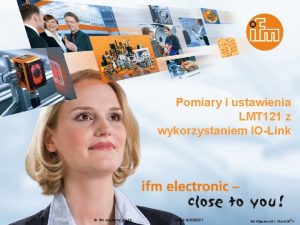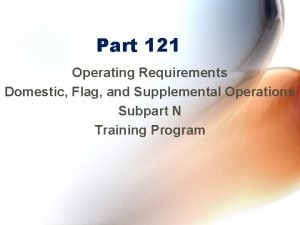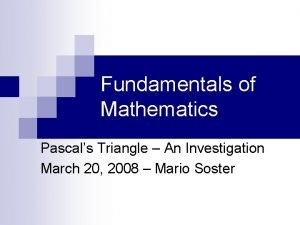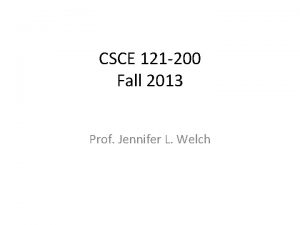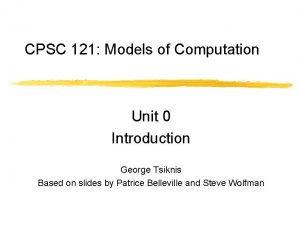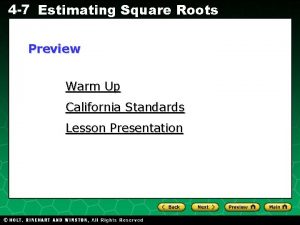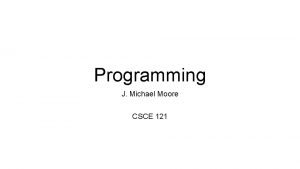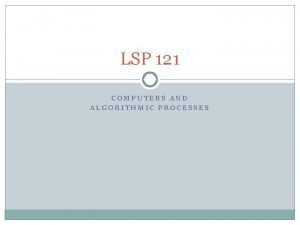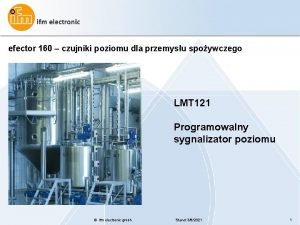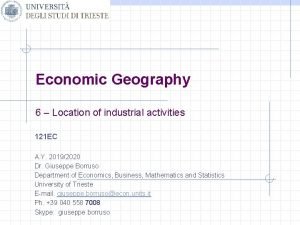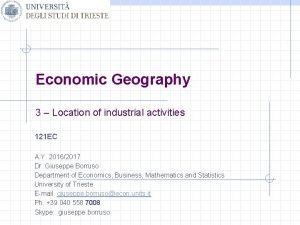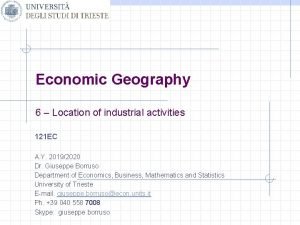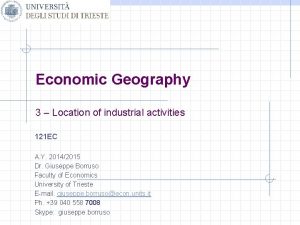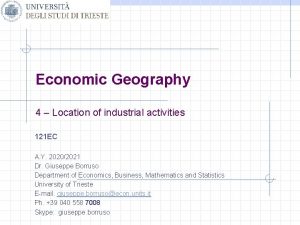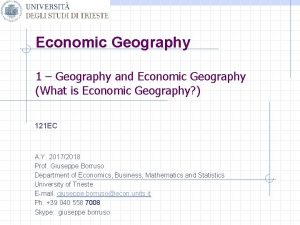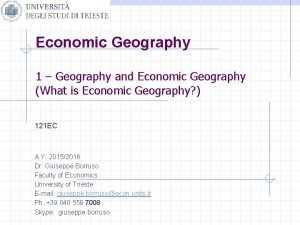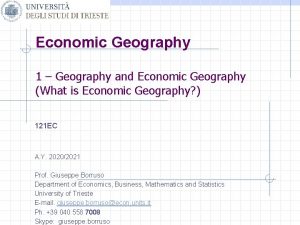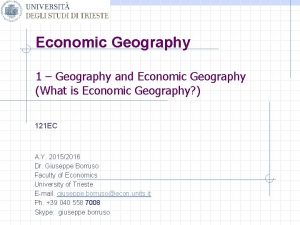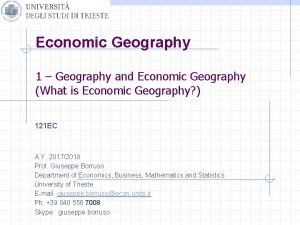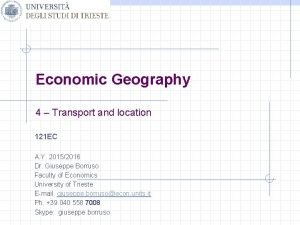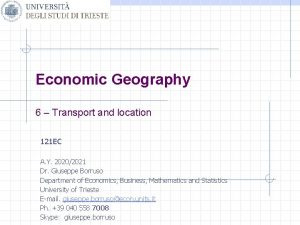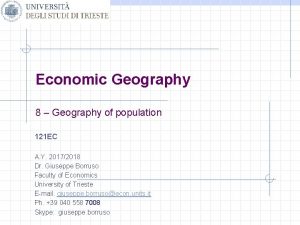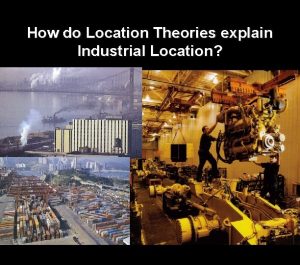Economic Geography 5 Location of industrial activities 121



































![Industry clusters (Porter’s definitions) w “[…clusters are] a geographical concentration of firms interconnected by Industry clusters (Porter’s definitions) w “[…clusters are] a geographical concentration of firms interconnected by](https://slidetodoc.com/presentation_image_h/1339c7465843bdf6543a1a6759988300/image-36.jpg)





























![PORTER’S DEFINITION “[…clusters are] a geographical concentration of firms interconnected by being part of PORTER’S DEFINITION “[…clusters are] a geographical concentration of firms interconnected by being part of](https://slidetodoc.com/presentation_image_h/1339c7465843bdf6543a1a6759988300/image-66.jpg)













- Slides: 79

Economic Geography 5 – Location of industrial activities 121 EC A. Y. 2019/2020 Dr. Giuseppe Borruso Department of Economics, Business, Mathematics and Statistics University of Trieste E-mail. giuseppe. borruso@econ. units. it Ph. +39 040 558 7008 Skype: giuseppe. borruso

Learning Objectives w In this lesson we will: n n Introduce the industrial location’s factors; Examine the spatiality of location factors; Focus on: industry clusters (industrial districts); Present Weber’s theory of industry location

Topics 1. 2. 3. 4. Industry: characteristics Factors of industrial location Insight: diffusion processes ‘Geographical’ production factors 1. 2. Industry clusters The Silicon Valley case 5. Industrial location theory

Industry: characteristics w Industrialization is an essential aspect of World Economic Growth w Dimensions, transformation of spaces, impact on economies, effects on development and lifestyles. w Industry: from manifacturing to ‘trivialization’: from the secondary sector to (almost) every production type

Industry. Production systems w Vertical n n Production processes linked together in line Transformation of raw materials in a final product (i. e. , steel industry) w Orizontal – lateral n n Differentiate productive processes To converge in an assembly industry (i. e. , automotive) w Services n Production processes of services, organized by other operators (i. e. , energy supply, transport infrastructure)

Industry. Main categories w Mining industry n (basic) w Manifacturing n (processing) w Construction w Energy

Industry. The ‘revolutions’

Industry. The ‘revolutions’ w I industrial revolution n n w II industrial revolution n w End XIX Century - Beginining of XX century Coal -> Oil, hidroelectrig energy New industries, new locations, new markets, new products. Series production. Fordism III industrial revolution n n w England (XVIII – start XIX Century ). Steam machine (James Watt, 1783). Coal; iron; textiles New organization of labour (it substitute the ‘makers’ model) Countryside – City movements and migrations End of XX century – To-date Hi tech: electronics, robotics, telecommunication, bio-tech IV industrial revolution n n Cyber-physical systems Makers Circular economy 3 D Printing


IV Industrial revolution

Industrial location w Spatial distribution and location of industries: n Inserting a manufacturing firm in a given territory is important in terms of the spatial reorganization of: w w w Demographic component; Urban structure; Other economic activities; Network of flows and traffic; Political- social rules. w Industrial geography: where and why industries in a given territory n n => location as a process of setting an industry. It is important to examine: The factors of industrial location; The ‘geography’ of production factors; Location theories

Industrial location w Geographical studies on the spatial distribution and location of manufacturing activities; w Factors of industrial location; w ‘Geographical’ production factors; n n Land Capital Labor Information w Scale, manufacturing relocation and spatial concentration w Industrial location theory n n Weber, Smith Hoover, Palander

Industrial location’s factors w Natural elements n Environment influences location n Industries influence environment moving resources and technologies (i. e. , water) n Industry-nature relationship (externalities) w Technical factors n Energy supply; n Organization of transport systems; n (technological changes make the location issue a more elastic one) w Demographic factors n Population-industry relationship n Population = demand of products; = workforce supply n Expected demographic dynamics and socioeconomical qualities (gender, age, education, etc. ) w Historical-cultural factors n ‘endogenous culture’ of a territory: pre- industrial organizational production often put he basis for future industrial setting. n (industry not always an element of break with territory) w Economical factors n. More complex ones and directly related to the nature of the production activity n. Capital, work, land+ knowledge (entrepreneurship and managerial education) w Psycho-social factors n. Non-objective elements of territory; n. Actors and strategic choices: relocation; delocalization, multi-localization n. The cognitive and perceptive behavior of the company’s decision maker is relevant n. Relevant the environmental amenities n. Knowledge or ‘perception’ of the competitors’ spatial structure w Political factors n. Regional economical development n. Political target = avoid interregional imbalances deriving from a high industrial concentration (spatial planning => capacity of intervention over different aspects concerning a territory’s organization)

Spatiality of production factors w Economics analyzes scarcity, w w w remuneration, accumulation of production factors; Spatiality (spatial dimension) Land Capital Labor Information n Entrepreneurial and managerial culture, innovation capacity

Spatiality of production factors w Land: n n n Location (space) Physical support to the social organization (territory) Container of renewable and non-renewable resources (environment) Accessibility (transport) Physical location of industry w Competition with other human activities; w Preference for flat lands; water; waste disposal w Land <> climate (advantages of setting in certain climate zones) w Land vs territory (space transformed by work: cities and communication networks) w Land as set of renewable resources

Spatiality of production factors w Capital: n n n Usually considered mobile and non spatial Technical component of capital is located in the existing production places => places where investments for innovation and modernization will be directed (capital intensive structures) Financial capital in a free market chooses the areas in which a stable development is present (reduction of uncertainty) Consequences on the capital’s costs (interests) => financial instrument used as regional development policy Bank system and location of credit management structures

Spatiality of production factors w Labor: n n n n Production factor whose supply is more uniformly distributed in space Historical empirical evidence: long range migrations towards places of high workforce demand From a qualitative point of view, work is not mobile in space (related to a given territory) Labor is not related to the regulation of markets as it is an element of spatial organization and at the same time oriented and qualified by place. Economic neoclassic theory: Labor = undifferentiated set and production factor expressed by its price (without considering the social context) => ‘a-spatial hypothesis’: 1. Employers and employee hold a satisfactory knowledge of employment and wages thanks to the market; 2. Individuals are rational (maximization of profits and wages) 3. Individual decisions are not influent over the general level of wages 4. There are no obstacles to the mobility of labor 5. Labor = exchangeable and homogenous in every particular market

Spatiality of production factors w Labor: n n n It’s a ‘living’ production factor, not just a SIMPLE input Worker = carrier of a cultural process deriving from the environment Labor = pseudo-commodity Labor is crucial in location. The cost of a unit of labor increases more than the average of the production costs. Location processes and production conversion: 1. Industrialization in ‘new countries’ (NIC – new industrialized countries) having a low cost of the workforce 2. Specialization of the countries of ‘old’ industrialization in sectors producing capital-goods and non standard consumption goods and dedicated to selected and nonfragmented market shares.

Spatiality of production factors w Information: n Technical knowledge (know how) w w w Network of centres Network of the existing industrial development Entrepreneurial innovation Research and development Innovation diffusion n Filtering down Learning by doing Learning by seeing w Telematics - ICT n Political – economical information w Role of ‘capital cities’ in industrial location (es. Rome after Milan and Turin)

Industry: Scale, production decentralization, spatial concentration w Location choices and production scales w Optimal dimension: production techniques in the different industry branches n n Steel industry integrated cycle; automotive; Production place <= external to industry environment (physical and human resources) Emphasis on the market: large vs small (residual) enterprises; Objection = existence of spatial systems of small and medium enterprises: w w High competition; Economies of agglomeration; Specialization of the different phases and stages; “spread manufacturing” (see industry clusters)

Industry: Scale, production decentralization, spatial concentration w Tani (1987): n n Relationship between technological development, market dimension and economic production scale does not necessarily imply bigger dimensions of single production units: Technical de-construction of the production process: 1. By means of the organization of the same firm in parallel lines; 2. Decentralization of some of the production stages outside the company / firm (productive decentralization); 3. Organization of a system of firms / enterprises geographically contiguous and functionally integrated in small and medium enterprises (industry cluster).

The recombination of the production process Phase“D” Phase “A” Phase“F” Phase“C” Phase“B” Phase“E” Phase“A” (n=3) Phase“D” (n=4) Phase“F” (n=1) Phase“C” (n= 7) Phase“B” (n=2) Phase“E” (n=5)

The new model of industrial production Centre Semiperiphery Periphery Strategic decisions Big manifacturing Research and development Production Sales Production Multinational Firm Strategic decisions Sales Research and development Production Sales Production Transnational Manifacturing Strategic decisions Sales Research and development Sales Production Sales Legend Juridical framework Business relationship Decision maker Delocalized à Activity

The product lifecycle process Innovation No change Components’ substitution Low complexity change Product improvement Medium complexity change New product radical change New process Product’s lifecyclce Improvement of exhisting process Innovation’s product New generation process No change

Rate of product’s sales Factors influencing the product’s lifecycle Time Capital Importance of elements External Economies Non specialized workforce Know-how Management Stage 1 Stage 2 Stage 3

Product’s ratio of sales Product’s lifecycle and spatial diffusion Production Time Ce al ntr as are e Semip ripher as al are Periph eral are as

Factors and spatial diffusion Capital Importance of elements External Economies Non specialized workforce Know-how Management Production Stage 1 Ce al ntr Stage 2 Stage 3 as Are pe Semi- as al are ripher Periph eral are as

Spatial diffusion In geography we highlight two macro types of diffusion: w Diffusion as relocation (original location is abandoned: migrations; industrial re-location); w Diffusion as expansion (sprading from one place to another one): n Contagion (direct contact: epidemics; economic crisis); n Hierarchical or ‘waterfall’ (diffusion follows different steps or stages: example - innovation). w w Bottom up Top down

Spatial diffusion - Expansion (a) - Relocation (b) - Combined effects of expansion and relocation (c) and (d)

Hierarchical spatial diffusion


Spatial diffusion: modes Principle of non-spatially dependant Hierarchical diffusion at successive moments of time Typical successive stages of diffusion rate during the diffusion process. For an innovation, they are called Innovators, Early majority, Late majority and Laggards Case study: Spatial diffusion in music https: //www. youtube. com/watch? v=_eu. GMu. X 8 EG 8

Industry Clusters w 1 st law of Geography (Tobler, 1970): “Everything is related to everything else, but near things are more related than those far apart” (distance decay effect) w => very few of us live in complete isolation from the rest of society. It is likely that many of our behaviours, choices, aspirations and ideals are influenced by those with whom we interact in our everyday lives.

Industry clusters n n Clusters illustrate why place still matters in the global economy. Michael Porter defines clusters as groups of similar and related firms concentrated in a small geographic area (Porter, 1998). w w w interconnected firms in the same fields, specialized suppliers, service providers, firms in related industries, associated institutions (such as trade associations, universities, technology transfer centers, etc. ).

Industry clusters (Industrial districts) w w w Industry clusters are geographic concentrations of competing, complementary, or interdependent firms and industries that do business with each other and/or have common needs for talent, technology, and infrastructure. The firms included in the cluster may be both competitive and cooperative. They may compete directly with some members of the cluster, purchase inputs from other cluster members, and rely on the services of other cluster firms in the operation of their business. Industry clusters are dynamic entities. They may change as the industries within them change or as external conditions change An important characteristic of clusters is that they are centered on firms that sell outside the local, state, or even national market Clusters may include government, nonprofit organizations, educational institutions, and other infrastructure and service providers whose presence is key to the strength of the cluster. An industry cluster is an interconnected group of industries and firms. It differs from trade associations, which may have a narrower membership and focus. n n A trade association, for example, may include the members of a single industry and focus entirely on lobbying. By contrast clusters are agglomerations of regional industries and interdependent firms that are key to the success of the industry in the state. Organized industry clusters contribute broadly to the well-being of the region by addressing workforce recruitment and training issues, developing needed infrastructure, and establishing research and training programs at universities and technical colleges, to name a few.
![Industry clusters Porters definitions w clusters are a geographical concentration of firms interconnected by Industry clusters (Porter’s definitions) w “[…clusters are] a geographical concentration of firms interconnected by](https://slidetodoc.com/presentation_image_h/1339c7465843bdf6543a1a6759988300/image-36.jpg)
Industry clusters (Porter’s definitions) w “[…clusters are] a geographical concentration of firms interconnected by being part of the same industry or the same supply chain, by a common resource or market, by similar philosophy, by facing similar opportunities and challenges or by collaborating with the same university or research institution” 1 w Michael Porter “Diamond of Advantage”, a model that offers insights into industry clusters and competitiveness: n regions develop a competitive advantage based on their firms' ability to continually innovate, and that economic vitality is a direct product of the competitiveness of local industries. [1] Michael E. Porter, “Clusters and the new economics of competition, Harvard Business Review, 1998

DEFINITION AND ADVANTAGES w Lower inputs and Set of enterprises competitive or cooperative, which produce and sell related products, facing common challenges and opportunities. transaction costs; w High quality information at lower cost; w Higher level of trust; w Skilled labour force.

EFFECTS ON ENVIRONMENT 1. Increase productivity → way in which companies compete; 2. Benefits on innovation; 3. Creation of new businesses.

Industry clusters: factors innovation and growth w The factors that drive innovation and a cluster's growth include: n n n FACTOR CONDITIONS: such as a specialized labor pool, specialized infrastructure, and sometimes selective disadvantages; HOME DEMAND: or local customers who push companies to innovate, especially if their needs or tastes anticipate global or local demand; RELATED AND SUPPORTING INDUSTRIES: nationally competitive local supplier industries that create business infrastructure and spur innovation and spin off industries; INDUSTRY STRATEGY, STRUCTURE AND RIVALRY: intense rivalry among local industries that is more motivating than foreign competition, and a local "culture" that influences individual industries’ attitudes toward innovation and competition government and chance. Historical accident and/or government actions tend to play significant roles in the development or location of industry clusters.

Industry clusters (Marshall definitions) w Location variables (Marshall): n n n Decreasing transport costs (not relevant in location) and spatial specilisation processes; Geographical, historical – political, psychological factors; Localized economies: w w w know how diffusion and capacity; Innovations and findings continuous through time; Trade and transport system development; Face to face agreement; Complementariety between industries specialized in terms of stages / phases (process) or types (of product); w Enlarging specialized labor market (immigrant) w Attracting entrepreneurial capacities. n n n Marhsall’s analysis considers firm as homogeneus or specialized BUT capable of being extended to different industries - external economies, and complementariety of the job market and consolidated on the demand of goods) Marshall does not analyse the work in means of developing activities Marshall admits the possibility of congestion diseconomies.

Industry clusters (Industrial districts) w Marshall (1920) identified the firm’s external economies, although internal to the district, the basic foundations' of the distrcts’ (or local labor systems) competitiveness. . w The spatial aggregation of several firms, each one operating in full technical and organizational efficiency, related in terms of production and distribution processes, determines a particular efficency condition for the overall economic system. w Economical advantages: n n n Reduction of production costs; Reduction of transaction costs; Innovative and incremental dynamics settings. w The environment allows an organization based on a non- hierarchical order. The spontaneous and self propelling character in producing external economies seems to originate from evolutionary stability and by the convergence of a set of socio-economical, institutional and manufacturing.

Industry clusters (Industrial districts) w Technological conditions: n n n Economies of scale relevant at plant level and not firm’s one; Technologies having minimal efficient dimensions at local, limitedproduction scales; Spatial concentration of the manufacturing relations among specialized companies. w Market conditions n n n A growing market Standardized growth of the market and of the related specific manufacturing techniques Lack of substantial changes within the market relationships w Firm’s external economies: n n n Economies external to firms but internal to local community; spread, as not appropriable individually by a single player; Localized, as belonging to firms rooted there; Localizing, as few and maintaining relations between neighbouring companies; Influenced by technological, market, socio-economical and geographical aspects; External economies are generated ‘unocunsciously’ through the operation of other different local actors payers within the district.

Industrial District vs. Cluster Industrial District w w Alfred Marshall 1890: area where concentrations of competing, complementary, or independent firms and industries do business together or have common needs; w Efficient and flexible w companies, usually small and medium sized; w w Cooperation and/or competition Giacomo Beccantini: “socio -territorial entities characterized by the active presence of both a community of people and a population of firms in a bounded area with a dominant industrial activity”; Local outsourcing; Economies of scale and scope. Cluster w Porter: “Geographical proximate group of interconnected companies and associated institutions in a particular field, linked by commonalities and complementarities of various types”; w Small, medium and big enterprises w are welcome Cluster’s players: n Firms n Financial Institutions n Public Actors n Universities and Research Institutes n Organizations for collaborations n Media

Clusters Vs Industrial Districts INDUSTRIAL DISTRICT w More defined boundaries CLUSTER w Less defined boundaries w Smaller space w Wider space w Homogeneity w Heterogeneity In products and sectors 44

Evolution of the Concept of cluster 1890 1950 s Marshallian “Industrial Districts” 3 Economic Agglomerations: - Of localization - Of urbanization - Internal returns to scale 1980 s 2000 s 1990 s New Industrial Spaces Italian Industrial Districts Industrial Clusters & Clusters Regional Innovation System Industrial Location

HOW CLUSTERS EFFECT COMPETITION Increasing productivity Driving the direction Add title here and pace of innovation Add title here Stimulating the formations of new business

The Cluster Life Cycle (1) 47

The Cluster Life Cycle (2) 1. Emergence: there are few firms pioneering a new product, technological path or even a completely new industry and therefore have the push to innovate even though competition is not fierce yet. At this point we don’t have a cluster yet, as only when the firms start to interconnect and create synergies we can start talking of clusters. This may or may not happen due to several factors, for instance the absence of supporting research institutions or the fact that firm simply develop very different cultures and take different technological approaches. 2. Growth: if technological trajectory homogeneity is achieved and spin-offs from the original firms occur, the cluster becomes more definable, and heterogeneity decreases. 3. Sustainment: the cluster enjoys stability of interconnection and the spread of technology is even among firms. This is a phase of stagnation. 4. Decline: the cluster faces a decline in the number of firms and an increasing number of mergers and acquisitions, capital moves away from the area and startups formation is close to zero. 48

LIFECYCLE WBEGINNING → multiple causes; WDEVELOPMENT → on average 10 years to gain advantage; competitive → responses from institutions; W → rivalry; DECLINE → internal or external factors.

Industry clusters (Industrial districts)

Innovative Clusters w Broersma “industry groups that have strong innovative links with each other, but weak innovative links with the rest of the industries ” w Informal unions of different kinds of organizations in which knowledge and discoveries flow without boundaries Porter’s Diamond of Advantage The Inner dynamic of an Innovative Cluster

Cluster’s Policies ”Organized efforts to increase growth and competitiveness of Clusters within a region, involving firms, government and research community” (The Cluster Initiative Greenbook). w Cluster policies are a mean to w w improve and succeed, rather than an end to reach a goal Sustain Network of SMEs as large companies are less dependent on territory Take advantage of geographical proximity in order to build trust and social norms Let the private sector lead Focus mainly on short-term Greenbook’s 6 Cluster Initiatives: 1. Research and Networking 2. Policy Action 3. Commercial Cooperation 4. Education and Training 5. Innovation and Technology 6. Cluster Expansion

Advantages and Disadvantages of Innovative Clusters Advantages w Innovative ideas arising from and take advantage of their expertise, presence of SMEs allow closer relationships with customers Clusters’ fertile grounds and Knowledge creation through Disadvantages Universities; w Overspecialization of the Cluster w Higher employment rates and wage w Lock-In effect growths bring economic growth, welfare and attract customers and w Cost-reduction most important than the need to innovate investors; w Poor relationships and trust among w Long-term relationships with the Cluster’s players which are the suppliers that will deliver highbasis for its existence quality inputs, merge of production processes in order to enjoy lower w Mismatch between long and shortterm strategies costs and economies of scale w Start-ups can easily find partners w Inability of comparing Clusters

Focus on: THE SILICON VALLEY CLUSTER 54

55

HISTORY: 1920/1940 Electric Engineering and Stanford’s entrepreneurial thinking THE ROLE OF STANFORD • Hiring of Frederick Terman(1925) • Creation of a start – up incubator Diffusion of entrepreneurial thinking and encouragement to students to follow the entrepreneurial path. HP is founded in 1939 REDISCOVERY OF ELECTRONIC COMPUTING • Alan Turing theorizes a programmable machine (1937) • Kondrad Zuse builds the first Turing machine (1941) 56

HISTORY: THE 1940’s The WW 2 and the role of cryptography NECESSITY TO DECRYPT THE NAZI MESSAGES • Strong push to develop automatic decrypting machines; • Creation of the first digital programmable machine (1943) • Invention of the transistor (1947) the foundation to the development of the computer industry are laid down. 57

HISTORY: THE 1950’s The birth of the semiconductor industry • Release of the transistor patent • Creation of The Stanford Industrial park with the purpose of creating innovation • William Shockley moves to the Santa Clara Valley and hires a lot of young engineers • Concentration of venture capital firms in the bay area The Bay Area becomes a very business friendly environment. • Fairchild semiconductors starts innovating the transistor technology -Usage of silicon instead of germanium -Development of the integrated circuit The semiconductor industry starts to flourish 58

HISTORY: 1960/1975 The inventions and the boom NEW WAVE OF INNOVATION BY FAIRCHILD • Bob Widlar produces the first “chip” (1963) • Dave Talbert creates the first analog integrated circuit (1964) • Frank Wanlass uses three layers (conducting, isolating, semiconducting) to build chips easier manufacturing and increased transistor density on boards. • Federico Faggin substitutes the aluminum control gates with silicon based ones low power consumption and heating, higher density Boom in the semiconductor industry in the area, with a lot of start-ups and spinoffs from Fairchild, that faced a lot of key employees leaving to 59 open their own company

HISTORY: 1960/1975 (2) The inventions and the boom MORE DEVELOPMENTS IN THE COMPUTER INDUSTRY • Foundation of Intel (1968) - invention of the dynamic RAM memory - Miniaturization of the processor, the first microprocessor is built. • East Coast firms such as IBM open their labs in the Silicon Valley - invention of the floppy disk A NEW TYPE OF CUSTOMERS ENTER THE MARKET • The hobbysists create the market for personal computer The Silicon Valley is “officially” born. a center of gravity for capital and ideas. 60

HISTORY: 1975/1980 The semiconductor wars and the coming of Apple THE MAIN COMPUTER PRODUCERS ENGAGE IN A WAR FOR THE MOST POWERFUL COMPUTER • Necessity to increase data storage • Necessity to optimize user interfaces and database management APPLE IS FOUNDED IN 1976 • Production of the Apple I • Boom with the Apple II • Implementation in the Apple II of the first spreadsheet program Record IPO in 1979 61

HISTORY: THE 1980’S Apple vs Microsoft AN INCREASED NUMBER OF INDIVIDUALS AND BUSINESSES REALIZE THE POTENTIAL BENEFITS OF USING COMPUTERS • There is an incredible demand for more compex software • New operative systems are required as the technology evolves Microsoft is hired by IBM to develop an OS There is a shift in the focus of computers, from harware-based to software based. In this context the battle between Apple operative system and Microsoft operative system takes place. With the former relying on proprietary technology and software, and the latter engaging a 62 more “open” approach.

HISTORY: 1990/2005 The Internet revolution and the dot-com bubble THE INTERNET BECOMES AVAILABLE TO THE PUBLIC • Creation of the market for browsers (Netscape Altavista and IE) • Creation of the market for search engines (Google and AOL) • Rise of the e-commerce and increased importance of websites for companies Incredible amounts of money invested into dot-com companies The Silicon Valley starts looking like it does now. Basically, a complex cluster of different industries that live in symbiosis, with high capital availability and productiviy. 63

HISTORY: 1990/2005 (2) The Internet revolution and the dot-com bubble THE LAST TWO WAVES OF INNOVATION IN THE SILICON VALLEY ARE SMARTPHONES AND SOCIAL MEDIA • Apple launches the first i. Phone (2003) creating a new market • Facebook is founded in 2005 64

65
![PORTERS DEFINITION clusters are a geographical concentration of firms interconnected by being part of PORTER’S DEFINITION “[…clusters are] a geographical concentration of firms interconnected by being part of](https://slidetodoc.com/presentation_image_h/1339c7465843bdf6543a1a6759988300/image-66.jpg)
PORTER’S DEFINITION “[…clusters are] a geographical concentration of firms interconnected by being part of the same industry or the same supply chain, by a common resource or market, by similar philosophy, by facing similar opportunities and challenges or by collaborating with the same university or research institution” 1 IN THE SILICON VALLEY WE HAVE w Firms part of the same industry (microprocessors, computers, software etc. taken separately) w Firms part of the same supply chain (the same sectors taken together) w Fundamental role of Stanford and UC Berkeley throughout the area’s history [1] Michael E. Porter, “Clusters and the new economics of competition, Harvard Business Review, 1998 66

PORTER’S DEFINITION (2) STANFORD VENTURE CAPITAL $$$ FIRMS PROXIMITY IN THE SILICON VALLEY 67

PORTER’S DIAMOND MODEL (2) FACTOR INPUTS • • • Cheap raw materials in the semiconductor era Steady production of talent inside Stanford Availability of Capital thanks to VC firms and successful IPO’s 68

69

PORTER’S DIAMOND MODEL (3) DEMAND CONDITIONS • • Shift from defense-only demand to hobbyists Hobbyists create the market for home based computers and provide input for further development As miniaturization occurs and software becomes more complex the demand for computers, software and microprocessors skyrockets New high demand markets arise with the coming of Internet 70

PORTER’S DIAMOND MODEL (4) RELATED AND SUPPORTING INDUSTRIES • • Many interdependent industries promote the transfer of knowledge and know-how; The different industries that coexist in the area support each other and often cooperate (e. g. chip, computers and software firms) 71

PORTER’S DIAMOND MODEL (5) FIRM STRATEGY, STRUCTURE AND RIVALRY • Positive effect of close competition in the various industries • • Coexistence of different approaches There are not dominant strategies and business models 72

THE CLUSTER LIFE CYCLE (2) 73

Cluster Life Cycle Emergence: driven by environmental advantages or market demand Growth: pressure on innovation, competition starts to emerge Sustainment: phase of stability, strategies of cost minimizing, fixed capital requirements Decline: investments drop due to new incumbent ideas/technologies Transformation: a new Cluster is formed from the previous one Stagnation: symbol Clusters remaining in the market Museum: disappearing Clusters

THE PRESENT SITUATION Dot-com bubble Global crisis 75

THE PRESENT SITUATION (1) 76

HETEROGENEITY CREATION APPLE w Prevents the emergence of a dominant design w Created the online music market w Created the smarphone market and all the related industries (apps) 77

78

79
 The statement of cash flows helps users
The statement of cash flows helps users Indoor and outdoor sports list
Indoor and outdoor sports list Support activities and primary activities
Support activities and primary activities Primary and secondary activities
Primary and secondary activities A cross country skier moves from location a
A cross country skier moves from location a In location planning environmental regulations
In location planning environmental regulations Secondary economic activities in the west of ireland
Secondary economic activities in the west of ireland Tertiary
Tertiary Tertiary economic activities paris basin
Tertiary economic activities paris basin Footloose industry
Footloose industry Economic activities
Economic activities Levels of economic activity examples
Levels of economic activity examples Tertiary economic activity
Tertiary economic activity Aztecs economic activities
Aztecs economic activities Economic activities by men and women
Economic activities by men and women Form utility marketing
Form utility marketing Simplified representations of complex economic activities
Simplified representations of complex economic activities Turkey economic continuum
Turkey economic continuum Economic growth vs economic development
Economic growth vs economic development Economic development vs economic growth
Economic development vs economic growth Lesson 2 our economic choices
Lesson 2 our economic choices Least cost theory
Least cost theory Isodapanes and isotims
Isodapanes and isotims Industrial location theories
Industrial location theories St. petersburg industrial district location
St. petersburg industrial district location Weber's model of industrial location
Weber's model of industrial location Kinds of industries
Kinds of industries Isodapane concept
Isodapane concept Weber's least cost theory ap human geography
Weber's least cost theory ap human geography Criticism of von thunen model
Criticism of von thunen model Tord palander theory of industrial location
Tord palander theory of industrial location Weight gaining industry example
Weight gaining industry example Tertiary activities in geography
Tertiary activities in geography Define absolute location.
Define absolute location. Location
Location Cartogram definition ap human geography
Cartogram definition ap human geography Mr help definition
Mr help definition Regions definition ap human geography
Regions definition ap human geography Nation state
Nation state Economic geography
Economic geography Economic geography
Economic geography Human and economic geography
Human and economic geography Types of economic geography
Types of economic geography Key concept review
Key concept review How to write an frq for ap human geography
How to write an frq for ap human geography 5 themes of geography ap human geography
5 themes of geography ap human geography Proruption ap human geography
Proruption ap human geography Psalm 121 1 3
Psalm 121 1 3 Psal 121
Psal 121 S7pct
S7pct Salmo 91 english
Salmo 91 english Isd-121
Isd-121 In4matx 121
In4matx 121 Ik hef mijn ogen op naar de bergen psalm 121
Ik hef mijn ogen op naar de bergen psalm 121 Phy 121 asu
Phy 121 asu Subprograma 121
Subprograma 121 Csce 121 tamu
Csce 121 tamu 121 to binary
121 to binary Cpsc 121
Cpsc 121 Eee 121
Eee 121 Dr junaid ahmed
Dr junaid ahmed Art 121 op
Art 121 op Pontener
Pontener Lmt 121
Lmt 121 Rva33.121
Rva33.121 Part 121
Part 121 Pascal's identity
Pascal's identity Csce 121
Csce 121 Cpsc 121
Cpsc 121 Cpsc 121
Cpsc 121 Simplify square root of 185
Simplify square root of 185 Csce 121 tamu
Csce 121 tamu Salmo 120 121
Salmo 120 121 Druha odmocnina z 8
Druha odmocnina z 8 Ordinal numbers 121
Ordinal numbers 121 121 computers
121 computers D&c section 121
D&c section 121 Lmt 121
Lmt 121 Doctrine and covenants 121
Doctrine and covenants 121 Types of context clues
Types of context clues







